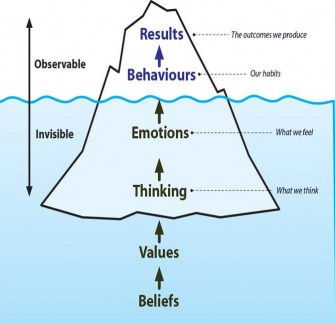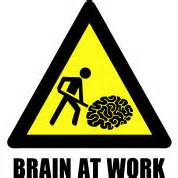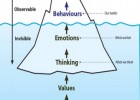
You no doubt have heard the saying that expecting a different outcome from doing the same thing is a bit insane, and yet, in my work with people I hear this kind of thinking time and again. For example, a company (read ‘human being making decisions within a company) sticks with a particular action that is not delivering what they thought, but they stick with it because that was agreed. Does that makes sense to you? So the action they are taking that is not working they stick with and expect a different outcome? It sounds kind of insane to me.
A model that is really useful when working with people is the ‘Iceberg Model’. This was originally used within cognitive behavioural therapy situations. I am not a behavioural therapist but I do find this Iceberg Model quite a useful place to start talking with clients about their results. The results they are getting and the results they want. There is usually a gap which is why we are working together.
Let’s have a look at this model.

- You can see at the top is the outcome or results being achieved. The result is above the water line. It is visible to others.
- These outcomes are in turn being driven by a person’s behaviours or habits. That is the things that they ‘do’. They might be visible to others, or maybe just themselves.
- Also below the water line, what and how a person ‘does’ is being driven by their emotions, how they are feeling.
- Shaping and creating those feelings/emotions are a person’s thoughts. What are they thinking? Each thought will create a negative or positive charge in the brain.
For example: I wake up and start thinking about a particularly challenging meeting I have. I start imagining all sorts of things that will go wrong and scare myself silly with those thoughts. I stay in bed a bit longer feeling a bit stressed. Finally I get up, too late for a run. Just time to run to catch the bus. Arrive at the office a bit late, feeling stressed, behaving in a negative way and arrive at the meeting expecting the worst. You can imagine how well I am operating and how well my brain is functioning.
Let’s play it again: I wake up and start thinking about a particularly challenging meeting I have. I put those thoughts aside and get up and out for a run. As I run I think about my preparation for the meeting and decide to think about the possibilities this meeting might offer me – for learning, challenge, growth, success… I arrive at the office on time, feeling good physically, thinking solutions, not dramas. My behaviour is positive and supportive.
 This kind of process is happening in our brains ALL THE TIME. We think something, we feel something, we take action or behave from that and we achieve an outcome. If you want to make real change, then let’s get down and into how you are thinking about things. If the way you are thinking is not useful, open, solutions focused then you can choose to find another way to think. YOU after all, are in charge of what you think, and how you think about it.
This kind of process is happening in our brains ALL THE TIME. We think something, we feel something, we take action or behave from that and we achieve an outcome. If you want to make real change, then let’s get down and into how you are thinking about things. If the way you are thinking is not useful, open, solutions focused then you can choose to find another way to think. YOU after all, are in charge of what you think, and how you think about it.
Remember, just because you have a thought doesn’t mean you have to keep it!
So often, a client when first shown this diagram will tell me they have seen it before, but no, they don’t really use it as a framework to check their thinking and results.
It is a simple and very powerful tool to keep checking that you have useful thinking. I mean useful in the context that it creates a positive emotional state that drives you to make and take positive action and behaviours to achieve a different outcome.
Finally, way deep down, below thinking, if there is a hierarchy to this, there you have your own personal values. Your values are those things that are really important to you. What you value will inform and shape what you think about and notice. In other words it helps cue your brain to notice those things, and just as importantly to notice when they are not present for you, that in turn creates inner conflict.
Last but not least you have your Beliefs. We all believe the world is a certain way which again our brain will find evidence to prove you right. Your beliefs are like your operating software. It is always running. Sending instructions to your brain.
This model can be a really simple and powerful tool to make changes and achieve different results. Over the next few posts I’ll break these 6 components down and talk a bit more about what is happening at each level and how you can use the power of each level, not just in your business or professional life but in all areas.
So, if the result is not what you want check your behaviours, emotions and thinking. Notice what values might be coming into play. Finally, ask yourself what you believe about this particularly result, opportunity and so on. Get mindful. Get used to thinking about your thinking.
Another thought about this. Notice just how much of a human being is below the water line. Each person has their own feeling, thoughts, values and beliefs. Next time you notice someone behaving negatively, be sure to just notice and not judge, because who knows what might be lurking beneath their water line!
Would love to hear from others who already use this approach to their work, day, life, or from others trying this out for the first time.
Please leave a comment.




